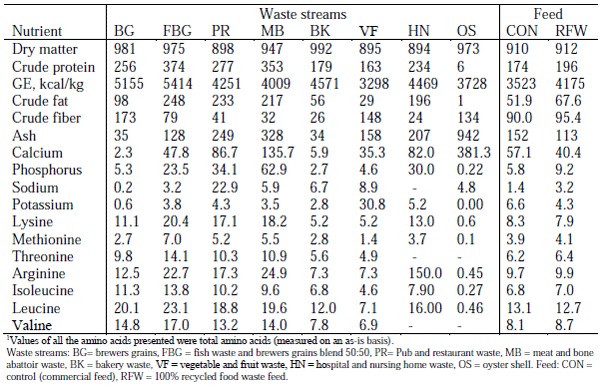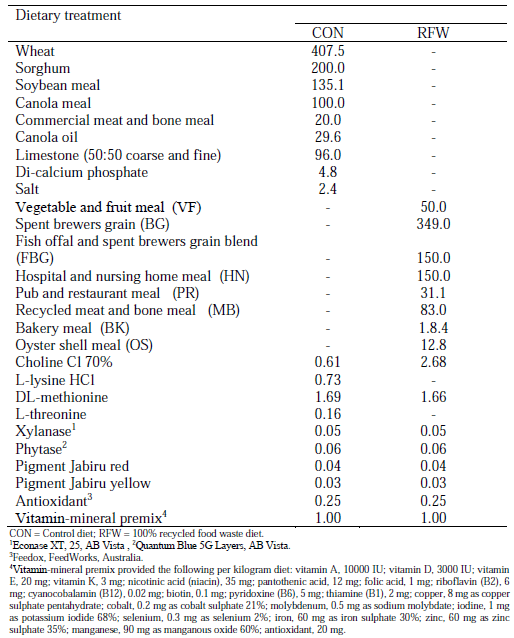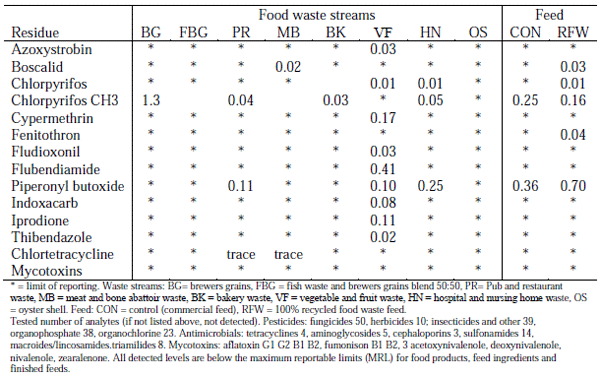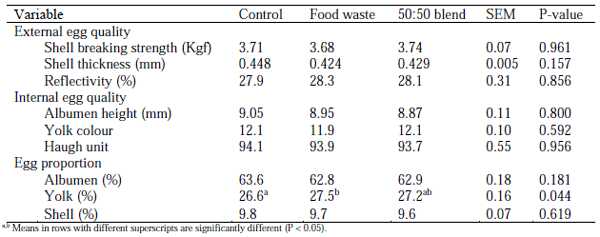I. INTRODUCTION
Feeding the world’s projected burgeoning human population increase of 2.2 billion people by 2050 will place tremendous pressure on food security. The poultry industry is innovative and well positioned to address this problem through increased efficiency and waste reduction. Globally, 32% (by weight) of produced food − equivalent to 1.3 billion tons − is lost or wasted every year. Conversion of food waste into raw materials for production of poultry feed offers a potential solution to address both waste management and food security challenges. However, using food waste as a nutrient source for poultry is not without challenges. Issues associated with the logistics of collection, spoilage, chemical residues, pathogens, processing and digestibility need to be addressed. Feeding waste to livestock is not a new concept. Raw swill has been fed to pigs for centuries, but has been banned in developed countries due to presence of residues and pathogens.
Typical kitchen and restaurant waste contains around 50% to 85% moisture that must be removed if a stable product is to be produced (Myer et al., 1999). Dewatering followed by short-time, high temperature drying is an effective drying method that minimises spoilage organisms and potential pathogens. The results of feeding dry waste streams to pigs have been reported (Kwak and Kang, 2005; Westendorf et al. 2000; Myer et al. 1999). Cho et al. (2000) reported on feeding dried leftover food waste to laying hens, where an increased protein level was required to maintain performance of hens fed the higher levels (200 and 300 g/kg) of food waste. Another study reported by Kojima (2005), found that feeding diets with 500 g/kg dehydrated kitchen waste had no effect on FCR or egg production but resulted in smaller eggs. A comprehensive review by Torok et al. (2021) concluded that food waste from retail and food service can be effectively and safety utilized in commercial production systems, as long as thecorrect processing and safety measures are implemented. A study is reported here that aimed to investigate the efficacy of recycled food waste from various streams formulated into a complete feed and compare it to a commercial type diet. Residue analysis, laying performance, egg quality and nutrient digestibility are reported. It was hypothesised that hens offered a food waste-based diet would perform similarly to those offered a commercial diet.
II. METHODS
Food waste streams were collected from breweries, pubs and restaurants, abattoirs, bakeries, vegetable and fruit markets, hospitals, nursing homes and fish processing facilities. The waste streams and finished feeds listed in Table 1 were analysed for nutrient content (AOAC, 2019), pesticide, antimicrobial and mycotoxin residues (Queensland Department of Agriculture and Fisheries Chemical Residue Laboratory, Coopers Plains). Amino acids and gross energy were assumed to be 65% digestible based on previous reports with pigs (Chae et al. 2000) and laying hens (Kojima 2005; Cho et al. 2004). Minerals were assumed to be 95% digestible. Each food waste stream was processed by steaming, maceration, dewatering, direct fired drum drying and particle size reduction as described in Dao et al. (2019). The patented process is designed to ensure inactivation of pathogenic and spoilage organisms with steam heating to exceed 100 deg C for 30 min (Boyle, 2018).
Treatments were: control (CON, commercial feed based on cereal grain and oilseed meal), 100% recycled food waste (RFW), and a 50:50 blend of CON and RFW. All diets contained additions of xylanase, phytase, L-lysine HCl, D,L-methionine, L-threonine, red and yellow pigments, antioxidant and vitamin-mineral premix. Table 2 shows the diet composition and Table 3 the nutrient composition from 24 to 37 wk. Feeds were mixed an additional three times from 37 to 44 wk, 44 to 58 wk and 58 to 64 wk, using fresh dried waste streams and conventional feed ingredients after analysis. Feed formulations required slight adjustments (not shown) as per assay results to keep the nutrient composition of each feed as constant as possible throughout the duration of the study.
Experimental procedures were approved by University of New England Animal Ethics committee. A total of 150 Hy-Line Brown 15-wk old pullets were fed a pre-lay diet from 15 to 19 wk of age, a commercial layer diet from 19 to 22 wk of age and were randomly allocated to the treatments at wk 23. Experimental feed was slowly increased during a 10-day adaptation period then the experimental diets were fed from wk 24. There were 50 replicate cages (30 cm wide × 50 cm deep × 45 cm high), each containing a single hen, per treatment. Experimental feed and water (one nipple drinker) were offered ad libitum. Feeds were formulated to meet minimum nutrient standards per the Hy-Line Brown nutrient recommendations (Hy-line Genetics, 2020). Hen day production, feed intake, egg weight, egg mass and FCR were measured wkly. Hens were weighed every 5 wk. Egg quality was measured monthly. Excreta was collected daily over a 3-day period to monitor moisture content and nutrient digestibility on 43 and 63 wk of age.
III. RESULTS
The average indoor shed temperature and relative humidity during the study ranged from 10.0 to 19.7°C and 49.4% to 76.1% respectively. Maximum daily temperature ranged from 13.0 to 29.0°C (average 20.4°C), while minimum daily temperature ranged from 4.0 to 14.0°C (average 10.4°C). The analyzed composition of various waste streams is given in Table 1. The fish offal and spent brewers grain blend (FBG), pub and restaurant (PR) and meat and bone (MB) wastes contained higher levels of crude protein (CP), crude fat, and total phosphorus relative to grains and oilseed meals (P and fat). Sodium (Na) content of the PR waste was higher than other commercially available ingredients and the Na requirement for hens. The final diets formulated with waste streams met the formulation objectives in terms of meeting the minimum nutritional requirements of Hy-Line Brown hens. The analysed nutrients of CON were similar to calculated values. In the recycled food waste (RFW) diets, the analysed CP, crude fat, calcium (Ca) and Na levels were lower, while crude fiber level was higher than calculated values (Tables 1 and 3).
The particle size distribution test showed that certain amounts of over-size particles (≥ 4 mm) were still observed in BK, MB, PR, FBG, HN and OS after processing. High percentages of fine particles (≤ 0.5 mm) were detected in BG (72.8%) and VF (72.3%). The residue levels for pesticides and mycotoxins are given in Table 4. All detected levels were below the maximum reportable limits (MRL) for food products, feed ingredients and finished feeds as per the Australian Agricultural and Veterinary Chemicals Code F2022C00839.
Over the entire study, birds in all treatments were visibly in good health. The mortality rates of the control, food waste and 50:50 blend treatments from 24 to 43 wk of age were 0%, 0% and 2%, respectively. There was only one mortality recorded in the 50:50 blend treatment and the mortality was not related to dietary treatment. No additional mortalities were observed from 43 to 63 wk of age.
Table 1 - Analyzed nutrient values of food waste materials from 24 to 44 wk (as-is basis, g/kg, otherwise as indicated).1
Table 2 - Ingredient composition of diets (as-is basis, g/kg ), 24 to 37 wk.
Hen weights and weight gain showed lower body weight in hens fed RFW compared to CON at 29, 39 and 43 wk. The laying performance from wk 24 to 63 is given in Table 5. Hens offered the RFW diets had similar egg weight, hen day egg production and egg mass, but lower feed intake (P < 0.001) resulting in a lower FCR (P < 0.001) compared to those fed the CON diets. Hens fed the RFW diets had approximately 22 points lower FCR compared to CON from 24 to 63 wk of age. Hens fed the 50:50 blend had intermediary FCR.
No treatment differences in internal or external egg quality were detected as shown in Table 6. However, the proportion of yolk as a percent of total egg was slightly higher in the RFW as compared to CON. Shell thickness and shell reflectivity (darkness of colour) were not affected by the dietary treatments (P > 0.05).
Table 3 - Calculated nutrient composition of diets, as-is basis, g/kg unless otherwise indicated, 24 to 37 wk.
Table 4 - Analyzed pesticide and mycotoxin residues of food waste materials and feed, as-is basis after processing, mg/kg, otherwise as indicated1.
Table 5 - Performance of hens fed dietary treatments from 24 to 63 wk.
Table 6 - Egg quality at 63 wk.
The results shown in Table 7 indicate a higher level of moisture in excreta from birds fed RFW as compared to CON (P < 0.01). The 50:50 treatment was intermediate. Dry matter digestibility was lower in hens fed the DFW compared to the CON (P < 0.05). Fat digestibility was higher in hens fed the RFW and 50:50 diets compared to those fed CON (P < 0.05).
Table 7 - Percent excreta moisture and apparent nutrient digestibility at 43 wk.
IV. DISCUSSION
When formulated to meet minimum nutrient requirements of the Hy-Line Brown, RFW diets contained higher concentrations of CP, crude fat, crude fibre, total P and Na compared to the CON diet. As the study progressed, and new batches of food waste were utilised, closer nutritional levels between the CON and RFW diets were observed in the second period of the study from wk 38 to 43 compared to the initial period (wk 24 to 37).
The 100% RFW diet had 912 g/kg dry matter (DM), 196 g/kg CP and 67.6 g/kg crude fat and 95.4 g/kg crude fibre. This was similar to the food waste collected by Cho et al (2000) with 937 g/kg DM, 206 g/kg CP, 99 g/kg crude fat and 89 g/kg crude fibre.
No mycotoxins were detected in waste streams or finished feeds in the current study indicating no issues with mould growth between collection of waste streams and processing and drying. The analytical screen for insecticides, herbicides, fungicides and antibiotics detected trace amounts of mainly insecticides in the dried vegetable and fruit waste stream. The highest was flubendiamide, a ryanoid insecticide, detected at 0.41 mg/kg DM basis. The MRL in Australia for this chemical in food vegetables (as is basis) ranges from 2 to 20 g/kg depending on the individual vegetable. Piperonyl butoxide, a common synergist agent used with pyrethrin based insecticides was detected at low levels of 0.11 mg/kg in PR, 0.10 mg/kg in VF and 0.25 in HN waste streams after processing. The MRL for this chemical is 8 mg/kg in vegetables and 20 mg/kg cereal grains for human consumption. The insecticide chlorpyrifos-methyl was detected at 1.3, 0.04, 0.03, 0.05, 0.25 and 0.16 mg/kg in BG, PR, BK, HN, CON and RFW respectively. The MRL for this chemical in cereal grains for human consumption is 10 mg/kg. The pesticide results all indicate that levels detected for food waste streams and finished feeds were below the MRL limits for human consumption as stated in Table 1 of the Australian Agricultural and Veterinary Chemicals Code F2022C00839.
In the current study, no differences were detected between CON and RFW for hen day production, egg size and egg mass. However, feed intake and FCR were lower in hens fed RFW as compared to CON with birds fed the 50:50 blend being intermediate. Cho et al. (2000) reported on feeding food waste at 100, 200 and 300 g/kg in normal and 10% higher protein levels against a control diet in isoenergetic diets. Food waste was dried in a fluidised bed drying apparatus (temperature and time not reported). Overall seven-wk results through peak production showed higher FCR, lower hen day production and no different in egg size with the 200 and 300 kg/t at normal protein. Increasing the protein by 10% improved performance of the 200 and 300 kg/t food waste treatments to that of control suggesting lower digestibility of the amino acid fraction of the food waste as compared to conventional ingredients.
Kojima (2005) reported on dehydrated kitchen food waste as an ingredient for laying hens at 125, 250 and 500 kg/t of feed. Food waste was dried at 65 deg C to 878 g/kg DM and contained 151 g/kg CP, 53 g/kg crude fat, 23 g/kg crude fibre and 3.1 g/kg Na. Hens fed the diet with 50.0% food waste had decreased egg weight but no differences in hen day production or FCR.
In the current study, relative yolk size was larger in eggs from hens fed the RFW as compared to those fed the CON. This was likely due to higher total fat in the diet and possibly higher levels of linoleic acid, although not analysed or reported. Eggshell breaking strength and shell reflectivity were not affected by the dietary treatments. In the study of Kojima (2005), eggshell strength tended to weaken with increased food waste in the diet and eggshell reflectivity was higher (lighter) with increasing food waste. The differences between the current study and those reported by Kojima (2005) may be due to differences in formulation and Ca content and Ca particle size.
In the current study, Na levels in the RFW diet exceeded nutrient recommendations for Hy-Line hens. The higher excreta moisture levels in the RFW fed hens was likely due to the higher levels of Na and salt causing increased water consumption. This could be an issue in areas of high humidity and may require lower use of the high salt waste streams or some other methods to remove the salt during processing.
The higher digestibility of crude fat and higher protein content in the RFW diet compared to the CON may explain the lower FCR observed in hens fed the RFW.
V. CONCLUSION
This study has clearly demonstrated the viability of using RFW as a feedstuff for laying hens. Feed conversion was improved as a result of feeding RFW with egg production and quality unchanged. No issues with pesticide, antibiotic or mycotoxins residues were detected. The food waste diets met or exceeded nutrient specification for laying hens and would provide both economic and environmental advantages by diverting waste from landfill. This study demonstrates that RFW is a highly feasible feed for poultry and represents an opportunity for sustainable and profitable poultry production.
Presented at the 34th Annual Australian Poultry Science Symposium 2023. For information on the next edition, click here. 

















.jpg&w=3840&q=75)